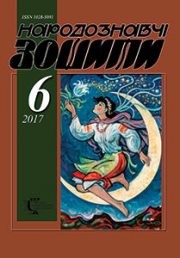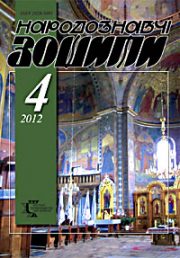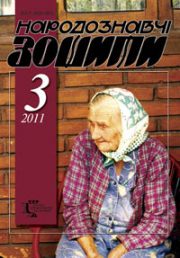The Ethnology Notebooks. 2020. № 4 (154), 867—880
UDK 745.51.021.7(477.8)”18/19”
DOI https://doi.org/10.15407/nz2020.04.867
CLICHES FOR BLUE-PRINT OF WESTERN UKRAINE: TYPES OF FORMS, TYPES OF CARVING, DECOR MOTIVES
BOLYUK Oleh
- ORCID ID: https://orcid.org/0000-0002-8292-202X
- Candidate of Sciences in Art Studies, Ph. D,
- Institute of Ethnology of the National Academy of Sciences of Ukraine,
- Folk Art Department,
- 15, Svoboda Avenue, 79000, Lviv, Ukraine,
- Contacts: e-mail: oleh.bolyuk@gmail.com
Abstract. The types of forms of clichй and artistic features of the handmade oil (on the top of fabrics) ornament of vybiyka in Western Ukraine, the little known artifacts kept in the museums of Lviv and Prague, are considered.
Actuality is predefined by the necessity of introduction for scientific turnover of expressive examples of traditional Ukrainian culture in the Eastern Galicia. The hand — ornament (vybiyka) by oil paints on canvas — one of the permanent markers of ethnic identity of Ukrainians of the western Ukrainian lands. There are few studies of this type of decorative art that enhances the sharpness of scientific problem.
The purpose of the article — to promulgate the results of research of specific of decor of homespun fabrics of Ukrainians by using wooden printing blocks of vybiyka. On the background development of traditional hand tools of hand painting (object of the research), forms and ornamentation of the printed cliches (subject of the research) are studied.
The structure of the work is based on the results of methods of artistic analysis, terminological, comparison; historical, systematic approaches; systems principles.
The material artistic artifacts of museums in Lviv, Prague, Vilnius and manuscripts of the Czech anthropologist F. Rzhehorzh became a source base of the study.
The novelty of the article is to present a little known sights of museums and clarify local names of the Ukrainian vybiyka in the late XIX — mid-XX century, description of corresponding to them ornamental patterns, which significantly improved the attribution of sights in the inventory monuments.
It is analysed that in made of the printed forms were used contr-relief and notched threads.
On the example of famous traditional, printed, decorative ornaments and contemporary interpretation of their motives it is indicated the difference between them. It is marked on individual aesthetic preferences of creativity in this area at the present stage of its development. It is also noticeable gradual revival of ancient crafts in the present time, however with a different interpretation of composition, motives of ornament, use of modern materials and facilities. There are still unclear questions in the study of Ukrainian vybiyka.
Keywords: hand beating, wooden cliches, types of carvings, ornament, Eastern Galicia.
Received 10.06.2020
REFERENCES
- Franko, I. (1905). Ethnological expedition to Boykivshchyna. Journal of Austrian folklore, XI (III—IV), 98—115 [in German].
- Fedorchuk, O., Bolyuk, O., Pohunek, J. & Valashkova, N. (2020). Traditional Folk Culture of Ukrainians in Austria-Hungary as Represented in the Ethnographic Collection of Frantisek Rehor from the 1880s and 1890s. The Czech Ethnological Journal, 107, 1, 71—92. Doi: http://dx.doi.org/10.21104/CL.2020.1.0 [in Czech].
- Kulchytska, О. (1959). Folk clothing of the western regions of the USSR. Kyiv: Publishing House of the Academy of Sciences of the Ukrainian SSR [in Ukrainian].
- Reinfuss, R. (1953). Polish folk print on canvas. Warszawa: National Publishing Institute [in Polish].
- Sydorovysh, S. (1979). Artistic fabric of the western regions of the USSR. Kyiv: Naukova dumka [in Ukrainian].
- Bilozub, V., Zabolotnyi, V., Ryl’skyi, М., Kasiyan V., & Manucharova, N. (Eds.). (1960). Ukrainian folk art. Fabrics and embroidery. Kyiv: State Publishing House of Fine Arts and Music Literature of the USSR [in Ukrainian].
- Bilozub, V., Zabolotnyi, V., Ryl’skyi, М., Kasiyan V., & Manucharova, N. (Eds.). (1961). Ukrainian folk art. Clothing. Kyiv: State Publishing House of Fine Arts and Music Literature of the USSR [in Ukrainian].
- Chuhai, R. (1979). Yavorivshchyna’s Folk Art. Kyiv: Naukova dumka [in Ukrainian].
- Bilan, М., & Stelmashschuk, H. (2011). Ukrainian costume. Lviv: Apriori [in Ukrainian].
- Dutka, R. (2002). Blue-print. In Pavliuk, S. (Ed.). Lemkivshchyna: Historical and ethnographic research: in 2 vol. (Vol. 2, pp. 274—278). Lviv: EI NAS Ukraine; Afisha [in Ukrainian].
- Dutka, R. (2007). Blue-print. In Pavliuk, S. (Ed.). A small encyclopedia of Ukrainian ethnography (Pp. 85—87). Lviv: EI NAS Ukraine [in Ukrainian].
- Dutka, R. (2007). Products are blue-print. In Pavliuk, S. (Ed.). A small encyclopedia of Ukrainian ethnography (Pp. 92—95). Lviv: EI NAS Ukraine [in Ukrainian].
- Dutka, R.М. (2007). Ivan Franko about blue-print. The Ethnology notebooks, 73—74 (1—2), 107—109 [in Ukrainian].
- Dutka, R. (2007). Blue-print technology. In Pavliuk, S. (Ed.). A small encyclopedia of Ukrainian ethnography (Pp. 588—589). Lviv: EI NAS Ukraine [in Ukrainian].
- Dutka, R. (2007). Blue-print fabrics. In Pavliuk, S. (Ed.). A small encyclopedia of Ukrainian ethnography (Pp. 589—591). Lviv: EI NAS Ukraine [in Ukrainian].
- Dutka, R. (1995). Ukrainian blue-print fabrics. The thesis for the academic degree of Doctor of Historical Sciences with a specialization in History of Art. Lviv [in Ukrainian].
- Dutka, R. (1995). Ukrainian blue-print fabrics (Dr. hist. sci. diss. abstr.). Lviv [in Ukrainian].
- Baibula, L.R. (2010). Collection of Jewish plue-prints in the Lviv Museum of Ethnography and Arts and Crafts. Bulletin of the Kharkiv State Academy of Design and Arts, 8/3, 191—198 [in Ukrainian].
- Tradition. Local business. Retrieved from: https://www.facebook.com/tradition.ukraine (Last accessed: 15.05.2020) [in Ukrainian].
- Volodymyr Markarian’s «Dyvo vybiykove». Retrieved from: https://rukotvory.com.ua/info/dyvo-vybijkove-volodymyra-markaryana/ [in Ukrainian].
- Oksana Bilous’s workshop. Retrieved from: https://www.oksana-bilous.com/ [in Ukrainian].
- Olexandr, Bryndikov (Briundik). Retrieved from: http://art.lviv-online.com/oleksandr-bryndikov-bryundik/ [in Ukrainian].
- Home factory. Retrieved from: https://fabrika-doma.prom.ua/p178041267-derevyani-shtampi-dlya.html [in Ukrainian].
- Nechyporenko, S. (2010). Blue-print in Ukraine: A textbook. Kyiv: Maisternya knyhy [in Ukrainian].
- Bolyuk, О. (2019). Blue-print’s matrices of the late XIX — first third of the XX century from the funds of Lviv museums: types of forms, types of carvings, decor motifs. Problems of preservation and popularization of cultural heritage: formation of museum collections (Pp. 6—17) (III International scientific-practical conference). Lviv [in Ukrainian].
- Bolyuk, О. (2019). Traditional beating in the fund of folk fabric of the Museum of Ethnography and Arts and Crafts in Lviv: art criticism of monuments. Art culture: history, theory, methodology (Pp. 47—49) (VII International Scientific Conference). Lviv [in Ukrainian].
- Bolyuk, О. (2020). Ornamentation of Ukrainian blue-print as a marker of ethnic identity (on the materials of collections). In Ramach, Y., & Drozd, R. (Eds.). Lemkos, Boyks, Hutsuls, Ruthenians — history, modernity, material and spiritual culture: a collection of scientific works (Pp. 321—333). Novi Sad: Faculty of Philosophy; Slupsk: Akademia Pomorska [in Ukrainian].
- Bolyuk, O., Fedorchuk, O., Nenartavichiute, E., Kumpikaite, E., Milashiene, D., & Rukuizhiene, Zh. (2019). Instrumentation for Decoration of Folk Textile as Source of Contemporary Print (on the Examples of Lithuanian and Western Ukrainian Folk Items). The International Young Scientists Conference «Industrial Engineering 2019» (Pp. 28—33). Lithuania, Kaunas: KTU; Faculty of Mechanical Engineering and Design. Retrieved from https://www.ebooks.ktu.lt/eb/1490/jaunuju-mokslininku-konferencijos-pramones-inzinerija-2019-pranesimu-medziaga/.
- Traditional and nontraditional blue-print: Exhibition. (2018). The Ethnology museum of national museum Autor exhibition Klara Binderova. Praha [in Czech].
- Isti Home: handmade for home. Retrieved from: https://istihome.com/product.
- Hoshko, Y.V. (Ed.). (1983). Boikivshchyna: Historical and ethnographic research. Kyiv: Naukova dumka [in Ukrainian].
- Mateiko, К. (1996). Ukrainian folk clothing: Ethnographic dictionary. Kyiv: Naukova dumka [in Ukrainian].
- Onyshkevych, М. (1984). Dictionary of Boyko dialects: in 2 part (P. 2. О—Я). Kyiv: Naukova dumka [in Ukrainian].







